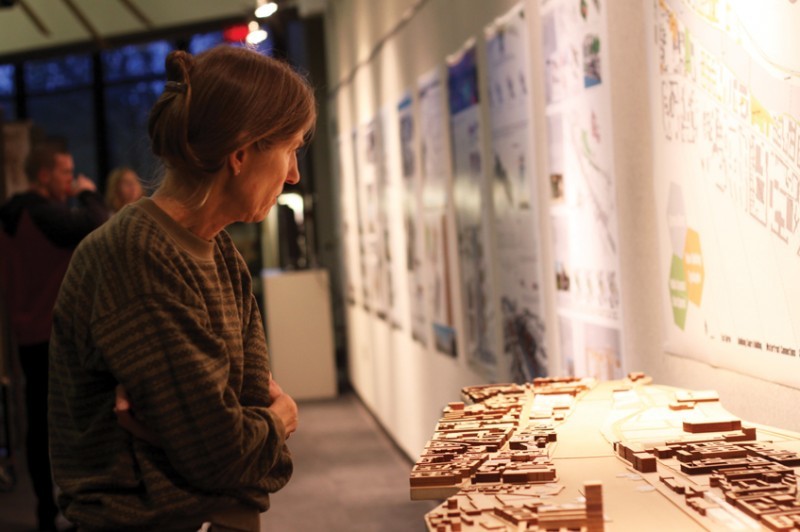Exhibit features work from students’ Berlin trip
Catherine Scott, citizen of Ames, looks at a model of instruction during “Toward Sustainable Cities” exhibition on Oct. 25 at the College of Design.
October 25, 2010
Sixteen College of Design students recently opened an exhibit showing their work, focusing on a trip to Berlin that took place this summer from May 28 to July 2.
Mitte is the central borough of Berlin. It’s bisected by the Spree River and was a breaking point for Germany when the Berlin Wall was built. Half the city was West Germany, half became East Germany.
“We were working in a hostile environment,” said Kristen Greteman, senior in architecture. “Businesses with a lot of money were buying up the land we were re-designing and making the area very impersonal.”
Greteman said throughout the mid-20th century the Berlin Wall created a lot of poverty and squatter areas. The wall basically ran alongside the river and heavily discouraged building projects there, leading to no new development and a bad architectural environment.
The ISU students on the trip, along with students from other universities across the world, focused on mediating an agreement between big businesses and small housing developments on the shoreline of the Spree.
“We had class from 8 to 5 almost every day. Lectures, city walks, studio time. It wasn’t really a classroom environment, it was a cultural experience,” said Clark Colby, senior in architecture and environmental studies.
The students also took time off from classes and brainstorming sessions to experience and learn about German culture. They visited a Cold War nuclear bunker and one of the first concentration camps that was constructed in World War II Germany.
Ulrike Passe, assistant professor of architecture, led the ISU students on this trip.
“They were a wonderful group,” Passe said.
She has lived in America for four years but travels back and forth between Ames and her home 10 miles north of where the students worked in Mitte.
“One of our biggest focuses was cleaning up the river [Spree],” said John Crispin, senior in architecture and environmental studies. “It was filthy, really not fit for any type of riverside recreation. They had this event called a ‘combined sewage overflow’ where raw sewage and rainwater would mix together in the sewers. The pipes can’t handle the load, so it spilled over into the river.”
Crispin and others helped design a system to process rainwater before it hits the sewer to help ease up the mixed content in the river. They have to be careful how they deal with the river because all the foundations of buildings along the shore are built on sediment. If the river gets drained, the buildings will crumble.
Other projects included converting private spaces into public walkways and accessible parks, turning an ancient cathedral into an art gallery, drawing people to a central place in the city, and making the riverside more aesthetically attractive and functional.
Adding sustainability was also a huge focus of the trip. Buildings were made to have a smaller carbon footprint, different methods of construction were addressed and sustainable housing was designed for people living in the city.
Crispin said all their work was hypothetical, but teachers at the Berlin Summer Academy did take notice in their plans.
The exhibit featuring artwork from students and posters explaining the purpose and achieved goals from the Berlin trip opened at 5:30 p.m. Monday, and was hosted by students and teachers alike. ISU Dining provided food for the event and tied things together with a sustainability-themed palette of choices.
“It’s a very eclectic-themed layout. We’ve got a fall theme going, a lot of squash was used,” said Jennifer Hakey, freshman in pre-journalism and mass communication and one of the waitresses serving that night. “No perishable items were used, no plastic or paper. We have glass plates and metal silverware.”
Among the food available was miniature pot pie, apple pie empanadas and pumpkin, corn and lemon grass shooters.
The night began with a few inspiring words from Luis Rico-Gutierrez, dean of the College of Design. He stated his appreciation of the design students’ eagerness to learn and help overhaul cities.
The exhibit is open until Nov. 4 this year and will end with a lecture titled “Energizing Architecture.”
“The president of this college has big plans to ready this school’s students to fight disease, overpopulation and hunger. But I believe that at the heart of all these issues is a design problem,” Rico-Gutierrez said. “I’ve always told my design students that their job is a simple one: Save the world. [College] is just practice.”

















